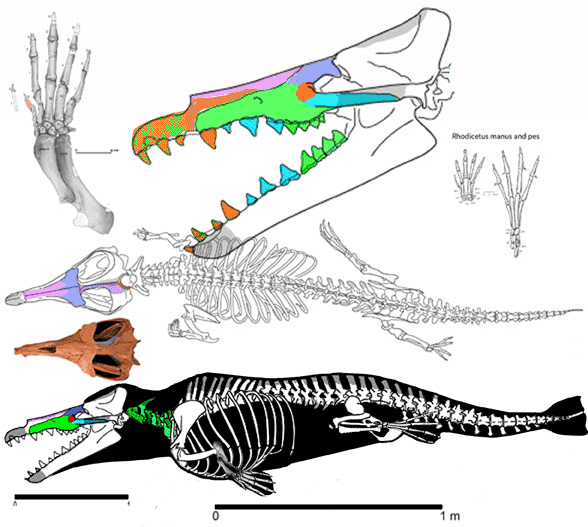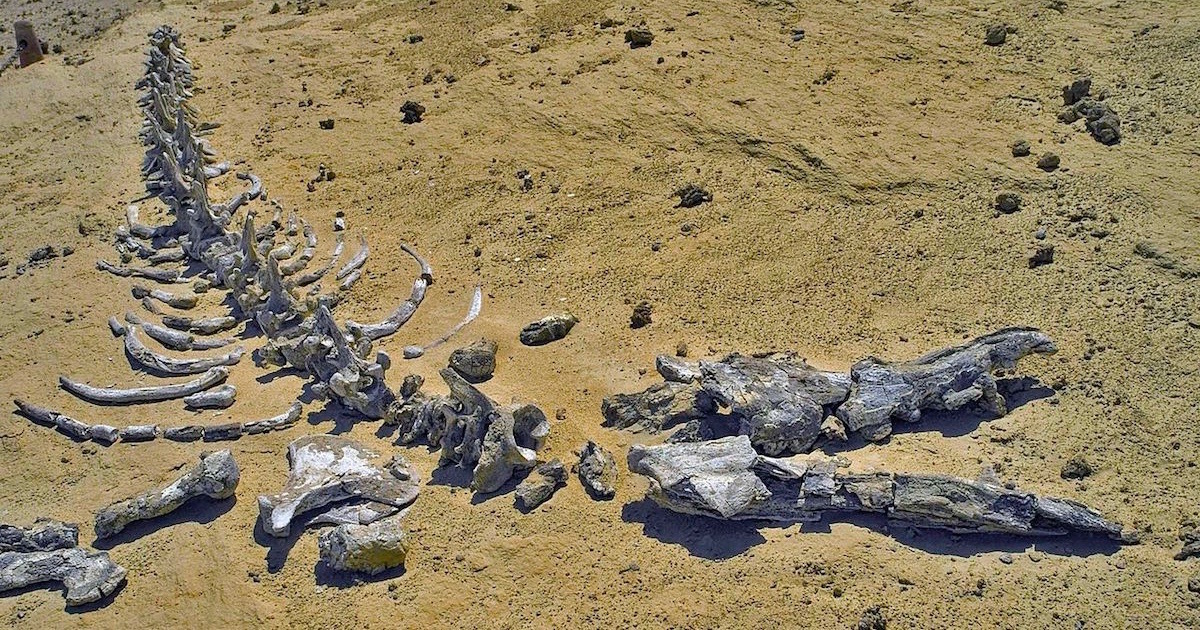These "they are all lying" stories usually turn out to be fantasies, but let's take a look...
Show us that.
http://thegrandexperiment.com/whale-evolution.html
See the section on Pakicetus.
The skull that was presented was a fabrication of Dr. Gingerich, and (at least at the time of writing that page) the fossils that were available had no "nose" section to begin with. In other words, he used his imagination to come up with a full skull, not actual fossils.
It would be rather odd, since the nostrils on Pakicetus were already known.
No, they were not.
Here is the original skull fragments that were found:
There is no way to have known whether the creature had a blowhole from these fragments.
From the link I provided above, talking about Gingerich:
He then created and supplied this full skull (above) to museums (the American Museum of Natural History in New York, The Ditsong National Museum of Natural History in Pretoria) and the producers of the National Geographic television special When Whales Had Legs. He also supplied this artistic drawing (below, left) of this “walking whale,” (complete with flippers, whale ears and whale neck) for the 1983 cover of Science. Later, a full skeleton of this same animal (below, right) was found in 2001. Contrary to what Dr. Gingerich had imagined, it was a land mammal. There was no blowhole; there were no flippers (only hooves); and there was no whale’s neck. Even so, the American Museum of Natural History in New York and The Ditsong National Museum of Natural History in Pretoria continued displaying the false “walking whale” skull with a blowhole supplied by Dr. Gingerich.
|
In other words, unlike Gingerich's imagined creature, Paki was a land animal.
Sounds like another "just-so" creationist story. But maybe not. Show us. Since the nostrils were missing on Ambulocetus,
I'm pretty sure we're talking about Pakicetus. Why the sudden jump to Ambulocetus?
but there was no blowhole on the head,
Sorry, but Ambulocetus is portrayed as having a blowhole. But the problem with that is that there are NO fossils that have the tip of the snout of Ambulocetus, which means that there is ABSOLUTELY NO WAY TO KNOW if Ambulocetus had a blowhole or not.
https://youtu.be/tkwhd_gIR7c
In the video, Dr. Werner asks Dr. Thewissen about the Ambulocetus fossil and its skull.
that wouldn't have been done. I showed you the first reconstruction of Ambulocetus, but there's no blowhole reconstruction at all. Take another look, at the reconstruction of the first Ambulocetid:
No such thing. They lied to you. No other way to put it. It would be impossible to fake a blowhole, since the part of the skull where the blowhole would be located, was there.
See the above video.
I have to say, this does no small damage to the credibility of the people who presented that dishonesty to you.
:blabla:
No, Barb, you've been misinformed. When the drawings of the fluke tail were first put out by Dr. Gingerich, there were no, repeat, NO tail fossils.
Then later, when they found foreleg fossils, they found out that it didn't have flippers at all (the bone structure is not one that can be spread out like flippers can), and because of that, it would likely not have had a fluke tail at all.
Here's Gingerich himself (in case you've forgotten, he's the discoverer of Rodhocetus) saying that he doubts that Rhodocetus had a fluke tail. 1:17
https://youtu.be/R7e6C6yUqck
There are enough specimens that the tail is known. The flesh was shown as a reconstruction. Here's an example:
See above.
So on what evidence did they infer a fluke?
By "they," do you mean Dr. Gingerich?
According to the man himself, it was speculation. See the above video, timestamp 0:45.
Question begging, Barb. Shame on you.
is much more adapted to swimming and less adapted to walking than ambulocetus suggests a fluke, as do the more robust tail segments.
EXCEPT IT'S NOT!
Gingerich DOES NOT BELIEVE ANY LONGER that Rodhocetus had a fluke tail, because the fossils they have now DO NOT HAVE FLIPPERS. 1:17 in the video.
You've been sadly misinformed. Are you willing to humble yourself and submit to the evidence?
The fact the hind feet were much smaller, and less effective for swimming, indicates that the tail was more important for movement. Hence a flattened tail was inferred.
Which has been retracted, due to the front legs not being flippers. Again, 1:17 in the video.
Compare to Ambulocetus, with a much less robust tail. We don't know for sure what the shape was, but it was a large tail and would be more efficient if flattened.
How do you know?
Why horzontally?
Because the first whales swam with a gallopiing motion, like otters. We know this because of Ambulocetus' feet. So it wasn't a sinuous motion like that of fish or reptiles.
Cite, please.
No, that's wrong. As I showed you, reconstructions are made with the missing (but inferred) parts unstippled to show. Your guys didn't realize what that meant, and blew it entirely.
Doesn't matter. As you see, the evidence doesn't support your beliefs.
Since your guy's story about Dr. Thewissen is unsupported, and since we've already caught him in a dishonesty, you'll need to provide some support for that one.
Well, that's a testable claim...
The whale ear, initially designed for hearing in air, became adaptedfor hearing underwater in less than ten million years of evolution. Thisstudy describes the evolution of underwater hearing in cetaceans, focusingon changes in sound transmission mechanisms. Measurements were madeon 60 fossils of whole or partial skulls, isolated tympanics, middle earossicles, and mandibles from all six archaeocete families. Fossil data werecompared with data on two families of modern mysticete whales and ninefamilies of modern odontocete cetaceans, as well as five families of non-cetacean mammals. Results show that the outer ear pinna and external auditory meatus were functionally replaced by the mandible and the mandibular fat pad, which posteriorly contacts the tympanic plate, the lateral wall of the bulla. Changes in the ear include thickening of the tympanic bulla medially, isolation of the tympanoperiotic complex by means of air sinuses, functional replacement of the tympanic membrane by a bony plate, and changes in ossicle shapes and orientation. Pakicetids, the earliest archaeocetes, had a land mammal ear for hearing in air, and used boneconduction underwater, aided by the heavy tympanic bulla. Remingtonocetids and protocetids were the first to display a genuine underwater ear where sound reached the inner ear through the mandibular fat pad, the tympanic plate, and the middle ear ossicles. Basilosaurids and dorudontids showed further aquatic adaptations of the ossicular chain and the acoustic isolation of the ear complex from the skull. The land mammal ear and the generalized modern whale ear are evolutionarily stable configurations, two ends of a process where the cetacean mandible might have been a keystonecharacter. Anat Rec 290:716–733, 2007.
ig. 1.A: Diagram of the land mammal ear.B: Diagram of themodern odontocete ear. For technical reasons, the mandibular foramen and the mandibular fat pad are shown on the lateral side of themandible, although they in reality are situated on the medial side. Abbreviations in Figures 1 and 7: Coc, cochlea; Dom, dome-shapeddepression for periotic; EAM, external acoustic meatus; FaPa, man-dibular fat pad; Inc, incus; Inv, involucrum; Mal, malleus; Man, mandi-ble; MeTy, medial synostosis between periotic and tympanic bone, incetaceans this synostosis is absent and is homologous to a gap between these bones (‘‘MeTy’’); OvW, oval window; Per, periotic bone;PeTy, joint between periotic and tympanic; Sin, air sinuses; Sk, skull;Sta, stapes; TyBo, tympanic bone; TyMe, tympanic membrane; TyPl,tympanic plate. Reprinted by permission from MacMillan PublishersLtd: Nature (Nummela et al., 2004a
http://repository.ias.ac.in/4651/1/321.pdf
So not at all what you were told. No surprise there.
https://youtu.be/GxcZCJ_WgXo
Dr. Thewissen was asked about the Ambulocetus's ear. This is the portion of the interview with Dr. Werner on it.












